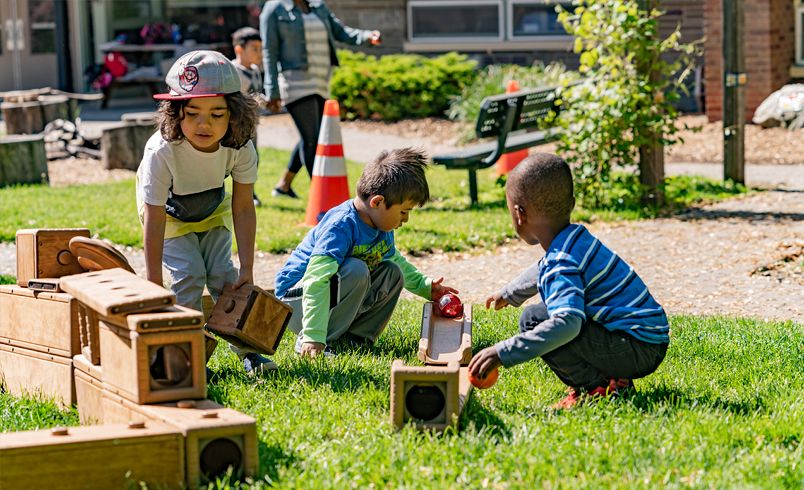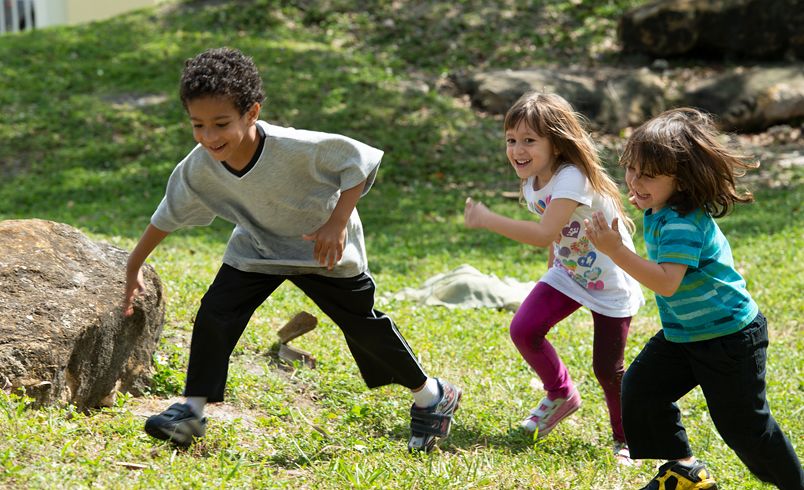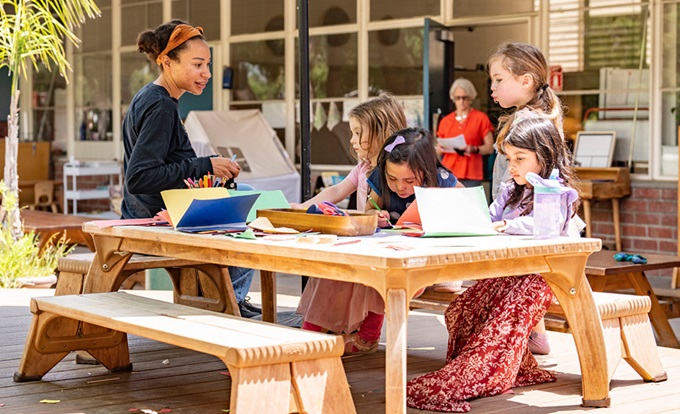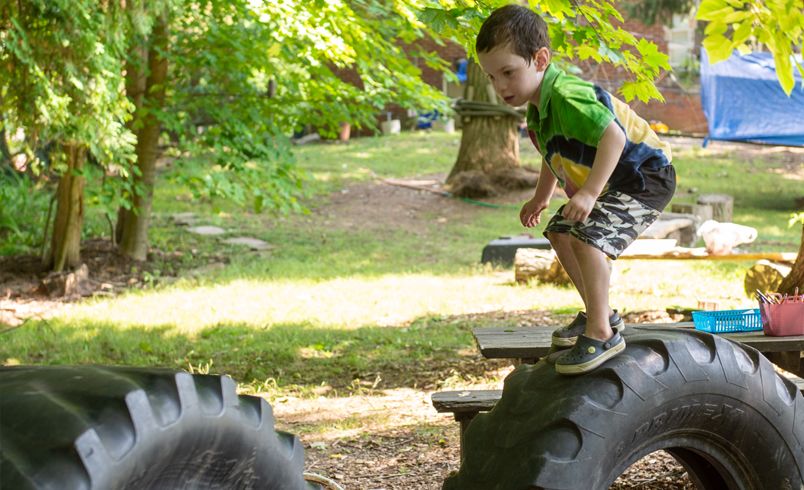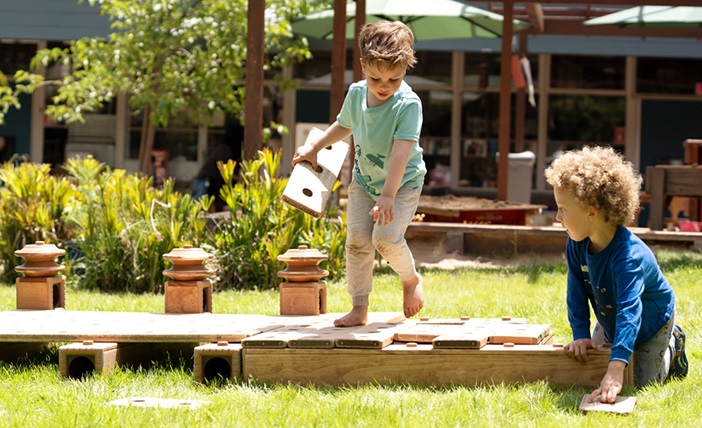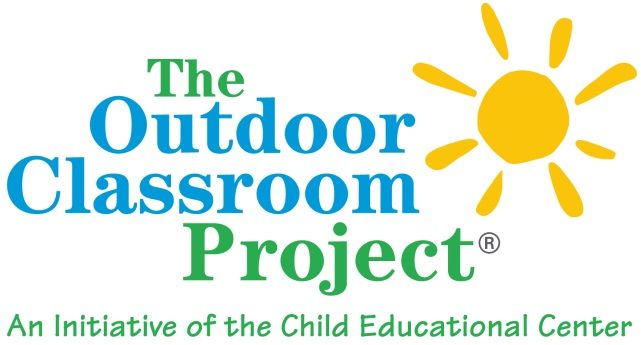Guidelines for Designing and Equipping Outdoor Play Yards
Recommendations from the Outdoor Classroom Project
| July 2019Most early care and education programs have outdoor play yards. However, because the outdoor program is usually not valued as much as the indoor program, often inadequate thought and financial support are contributed to the yard’s design and equipping. As a result, children’s activity in most yards is frequently lackluster and sometimes even harmful.
The Outdoor Classroom Project's goal is to increase the quantity, quality, and benefit of outdoor activity for children ages zero–five. Quality outdoor programs are more likely to happen when the play yards meet the following ten simple guidelines:
1. Adjacency
Play yards should always be adjacent to the classrooms of the children they are serving.
This fundamental design principle maximizes use of the outdoor space, effectively expanding the size and richness of a given classroom by the size and richness of the outdoor yard. In situations where existing programs lack adjacency, accommodation must be made through staffing and scheduling to maximize time outside.
2. Space
Play yards should always be large enough to contain the full variety of activities children require for healthy development outdoors.
This is a frequently ignored guideline as yard sizes are usually a minimum based on the number of children multiplied times so many square feet per child. In small preschool programs this creates yards as small as 1-2,000 sq. ft., much too small to accommodate the full range of activities children need. In such yards children lack activities required for full development, while activity areas overlap and conflict with one another. (See “Separation” and “Completeness” below.)
Irrespective of class size an outdoor space should be a minimum of:
1–12 months: 200 sq. ft.
12–24 months: 2,500 sq. ft.
Preschool: 5,000 sq. ft.
3. Layout
Open space (usually best in the center of the yard) should be large enough for children to run freely, with activity areas placed around the perimeter.
The single biggest mistake in the creation of new play yards is the purchase and placement of a large, expensive climbing structure on a piece of poured-in-place rubber in the middle of a small yard. Research has found when children have other options available, they play on such structures 2% of the time. (See “Materials/Equipment” below.) Yards need open space for activities that often change form.
4. Separation
Yard layouts need to separate those different types of children’s activities that might conflict with one another where they overlap in order to avoid safety risks and supervision challenges.
Another very common problem with yards is the inappropriate combining of activity areas. For example when sand is used as a fall zone material, it is common for children to play underneath climbing structures, creating a safety hazard. Trike movement is another common hazard when trikes are allowed to pass through other activity areas.
5. Completeness
Healthy outdoor development can only happen when there is the full range of activities that is required for development of the whole child.
The play yard is an “outdoor classroom”. In that spirit, most everything that can be done inside, can be done outside. The outdoor environment should have all of the activities found inside plus those that generally can’t be done in a classroom (e.g., trikes, swings, ball games). Each activity needs a defined, and usually, separated space. In some cases (e.g., art, reading, water play) that space can be movable and defined by movable items such as blankets, tables, or even just the presence of a teacher.
6. Materials/Equipment
A wide variety of materials/equipment is needed, with emphasis on items the children can manipulate.
Children learn through interaction with their environment. The more they are able to manipulate, the greater the opportunity for learning. Typical playground “equipment” such as fixed climbing structures are very limited in terms of children’s ability to manipulate them. The term “loose parts” describes items that lend themselves to manipulation and that foster creativity, problem solving, communication, teamwork and the like. Examples are milk crates and sand toys. More broadly, everything that is indoors should be found outdoors – art, reading, blocks, puzzles, music etc. For example, a child should be able pick up a book or get a teacher to read a story any time that child is outside.
7. Storage
There must be adequate outdoor storage to support the full variety of activities children require for healthy development outdoors.
Every activity area should have its own storage. It is unrealistic to expect teachers to move all the materials required for rich outdoor play from the inside outside and back each day. (A little is okay.)
8. Challenge
Play yards should provide challenge sufficient to support development of the whole child; challenge is defined as “reasonable risk”
Children under five years of age require significant, challenging physical activity to form the foundation for later cognitive development. They also need challenge in all other areas of development—the opportunity to manipulate materials, problem solve, communicate, work in teams, etc. Yards that are constructed with insufficient challenge delay children’s development. This is of particular concern for children whose primary or only outdoor experience is time spent in a center of early care and education.
9. Nature
Nature and a natural environment should be the dominant environment outdoors.
For many young children, the play yard at their center is their best opportunity for an experience of nature. The play yards of too many centers are dominated by concrete or asphalt, while the most common natural substance, sand in fall zones, is being replaced by poured-in-place rubber. Particularly for children living in urban areas, play yards should offer an opportunity for relief from the “concrete jungle”. Yards emphasizing nature provide children with unique learning opportunities (such as the importance of the environment and facts about the natural sciences) while providing the nurturing experiences that can only be found in nature.
10. Philosophy
Quality play yards must be accompanied by a philosophy that supports that quality.
A rich outdoor environment means nothing if children are not allowed to freely participate in it. Additionally, children will not be successful if teachers are not actively engaged with what the children are doing. Teachers must support children’s initiative, imagination and creativity as they develop activities for themselves that create the context in which learning takes place.
For more information on the Outdoor Classroom Project, go our website: www.outdoorclassroomproject.org.

